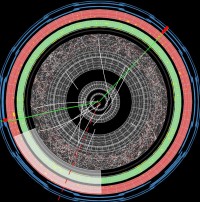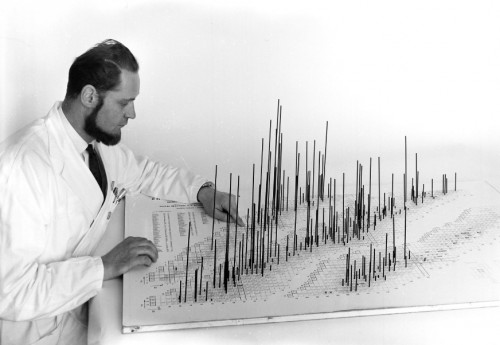Tag archives: CERN
Electrical fault delays LHC start-up
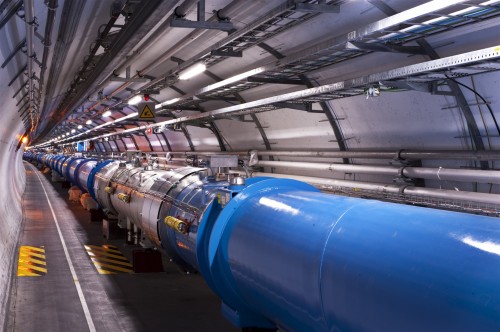
Back down the tunnel: technicians will soon be repairing an electrical fault somewhere along the LHC. (Courtesy: CERN/Maximilien Brice)
By Hamish Johnston
Today I was planning to write a cheerful blog celebrating the first circulating proton beams in the Large Hadron Collider (LHC), but sadly the particle gods are not smiling down on CERN this week. Accelerator physicists in Geneva have identified an electrical fault in one of the collider’s magnet circuits and plans to restart the giant machine this week have been put on hold – possibly for several weeks.
View all posts by this author | View this author's profile
What’s the latest matter with antimatter?
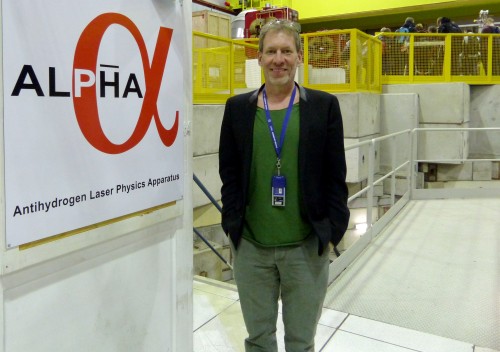
Mind over antimatter: Jeffrey Hangst at the ALPHA experiment at CERN.
By Tushna Commissariat at CERN
While visiting CERN, the world’s biggest particle-physics laboratory, it’s easy to get swept up by the excitement of the Large Hadron Collider and its detectors, especially in the run up to it being switched back on in the coming weeks. But CERN is also host to a variety of other equally exciting experiments that probe some of the biggest unanswered questions in science, such as the experiments that probe the unwieldy world of antimatter. Indeed, CERN’s antimatter programme has received considerable attention in the past, especially thanks to the now-famous book (and later, film) Angels and Demons, where some antimatter was supposedly stolen from the laboratory and used to build a bomb! Suffice to say, antimatter is of interest to physicists and the public alike and so I caught up with physicist Jeffrey Hangst, who is spokesperson of the Antihydrogen Laser Physics Apparatus (ALPHA) experiment, which I also had the chance to visit.
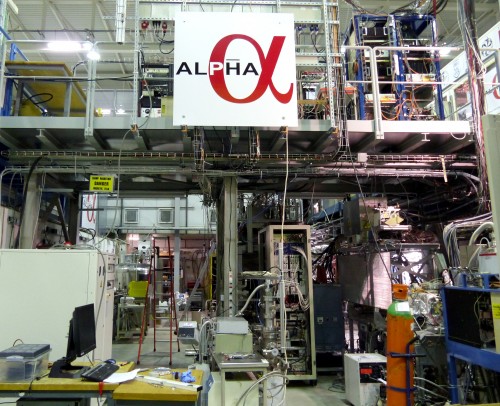
Antimatter factory: a view of the ALPHA 2 set-up.
View all posts by this author | View this author's profile
Physics mosh pit, stained-glass scientists, opera and dance at CERN and more
By Hamish Johnston
Last week Physics World’s Michael Banks was at the APS March Meeting in San Antonio, and at the top of his to-do list was to belt out a few tunes at the event’s regular physics singalong. You can hear him in harmony with a roomful of physicists in a rendition of “(You Got Me) Lasing” in the video above. It is sung by Walter Smith of Haverford College to the tune of Britney Spears’ “(You Drive Me) Crazy” and his performance drives the dance floor into a frenzy of moshing physicists.
View all posts by this author | View this author's profile
Last views of a huge particle detector before the Large Hadron Collider comes to life
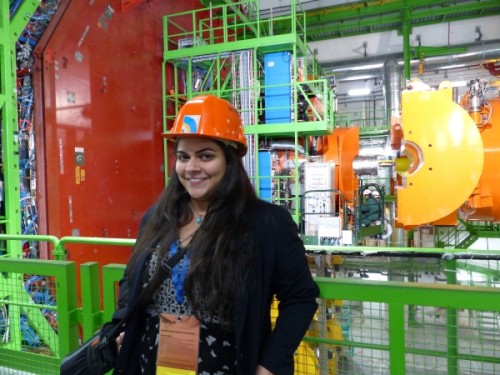
My photo opportunity: this could be the last we will see of the CMS for three years.
By Tushna Commissariat at CERN
Regular readers of Physics World will know that I am currently visiting the CERN particle physics lab in Geneva, ahead of the restart of the Large Hadron Collider (LHC) in the coming weeks. My first stop yesterday afternoon was a press conference in which CERN’s director-general Rolf Heuer and other leading physicists briefed us about “Run 2” and what researchers are hoping to discover. You can read about what they had to say here: “Large Hadron Collider fires up in a bid to overturn the Standard Model“.
I managed to squeeze in a quick last-minute visit to the Compact Muon Solenoid (CMS) detector before it is sealed up tight for the next three years. My host was CMS communications officer Achintya Rao, who took me and a few others deep underground into the bowels of the CMS – and what a sight it was!
View all posts by this author | View this author's profile
Pioneering women of physics, why you should become a particle physicist and a BICEP2 scientist on all that dust
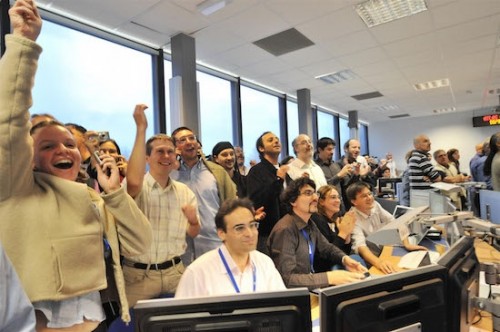
Smiley happy people: who would not want to be a particle physicist? (Courtesy: ATLAS)
By Hamish Johnston
Over on the Quantum Diaries blog, Aidan Randle-Conde has put together a lovely photo-essay called “30 reasons why you shouldn’t be a particle physicist”. It is reverse psychology, of course, and the 30 images highlight the benefits of devoting your life to studying sub-atomic particles. As someone who chose to do condensed-matter physics, do I now think that I made a huge mistake? No, but I have shared the thrill and excitement of being at CERN when the Higg’s was discovered and seen the Large Hadron Collider and its detectors up close, so I know where he is coming from.
View all posts by this author | View this author's profile
The LEGO Large Hadron Collider

LEGO Large Hadron Collider.
By Michael Banks
Avid readers of this blog may remember the 560-piece LEGO model of CERN’s ATLAS detector at the Large Hadron Collider (LHC), which was built by particle physicist Sascha Mehlhase of the Niels Bohr Institute in Copenhagen.
Not to be outdone, LEGO fan Jason Allemann then created a LEGO-inspired particle accelerator – dubbed the LEGO Brick Collider – that was submitted to the LEGO Ideas site, which lets fans share blueprints of their own models.
View all posts by this author | View this author's profile
Build your own LEGO particle collider
By Michael Banks
You may remember last year when particle physicist Sascha Mehlhase of the Niels Bohr Institute in Copenhagen unveiled a 560-piece LEGO model of CERN’s ATLAS detector at the Large Hadron Collider.
Well, not to be outdone, LEGO fan Jason Allemann has now created a LEGO-inspired particle accelerator. Dubbed the LEGO Brick Collider (LBC), the design has been submitted to LEGO’s CUUSOO site, which lets fans share blueprints of their own models.
View all posts by this author | View this author's profile
Become a CERN physicist in your bedroom
By James Dacey
Who discovered the Higgs boson? Was it Peter Higgs and a combination of other great minds? The experimentalists at CERN who analysed reams of data? The magnificent machinery of the Large Hadron Collider (LHC) itself? By the time that the next great breakthrough in particle physics comes along, the debate about who makes the discovery could become even more complex. That’s because a new citizen-science project is encouraging anyone with an Internet connection to search for new curiosities in the Higgs data.
“Higgs Hunters” launched this week and invites the public to sift through collision images from the LHC’s ATLAS detector. The task at hand is to look for the paths of charged particles that seem to appear out of thin air in what are known as off-centre vertices. As explained on the Higgs Hunters website, “some scientists think the Higgs could break apart into exotic particles entirely new to science”. On the Higgs Hunters website, citizen scientists help to count the number of particle tracks and can notify the science team if they spot anything out of the ordinary.
View all posts by this author | View this author's profile
Cthulhu cosmology, Halloween outfits with a physics twist and more
By Tushna Commissariat
It’s not often that classical physics and Post-Impressionist painters collide, but when they do the results can be enchanting and intriguing. In one of the latest TEDEd videos, Natalya St Clair has created a short lesson that looks at “The unexpected math behind Van Gogh’s Starry Night.” The video above looks at the enduring mystery that is the turbulence we see in any kind of flows in the natural world and how the human brain can recognize and actually make some kind of sense of the chaotic random patterns turbulence describes.
As pointed out in the video, famous physicists such as Richard Feynman and Werner Heisenberg have noted the complexity of turbulence, with Feynman describing it as “the most important unsolved problem of classical physics” and Heisenberg saying that “when I meet God, I am going to ask him two questions: why relativity? And why turbulence? I really believe he will have an answer for the first”. But is it possible that the undoubted genius and troubled painter that was Van Gogh perceived something more about turbulence in nature and is this most clearly represented in his most famous masterpiece – the evocative painting known as Starry Night? Watch the video to find out.
View all posts by this author | View this author's profile
Strange goings on at CERN, string theory with cats, Isaac Asimov on generating new ideas and more
By Hamish Johnston
“The past is a foreign country: they do things differently there,” is probably the only famous sentence written by the English novelist L P Hartley. It also sums up nicely a collection of photographs of CERN in the 1960s and early 1970s showing among other things a jolly worker wearing a beret, scientists wearing white lab coats and ties, and a strange religious-like procession. There are also lots of photos of vintage kit, including one of those huge vacuum-valve-powered oscilloscopes (probably from Tektronix) that would be familiar to physicists of a certain age. My favourite photo is shown above. It was taken in 1965, when 3D data visualization was actually done in 3D! I believe that the collection was put together by CERN’s Alex Brown and you can enjoy looking at all 55 images in the collection here.
View all posts by this author | View this author's profile
